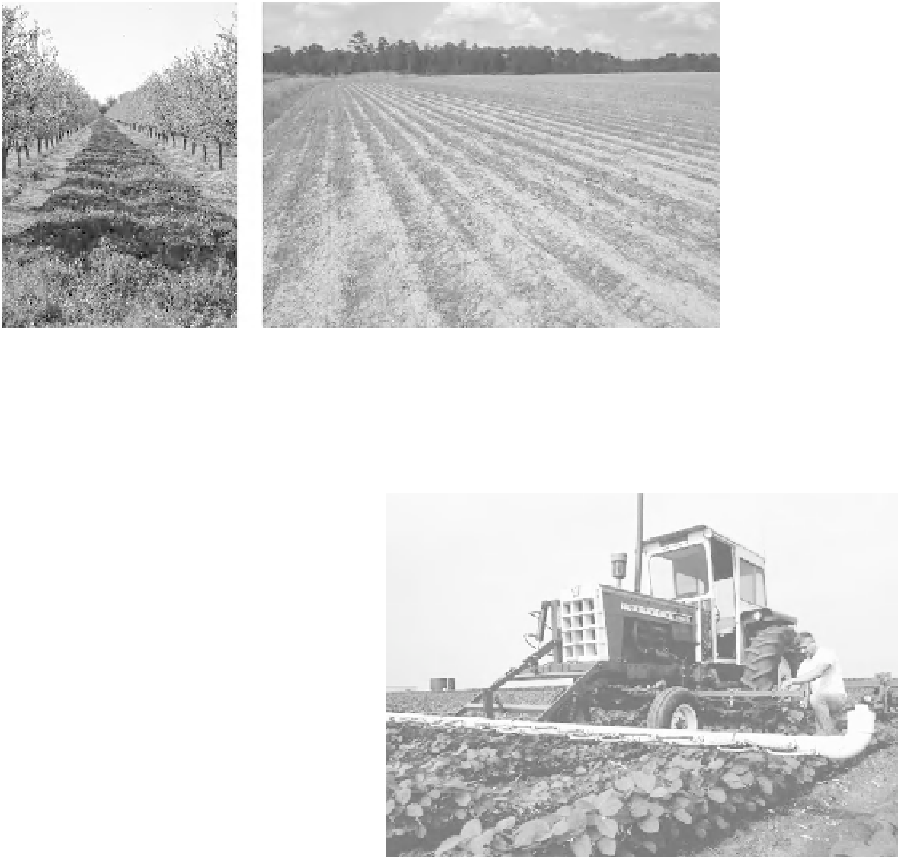Environmental Engineering Reference
In-Depth Information
(a)
(b)
Figure 6.22.
Cropping practices: (a) cover cropping; (b) conservation tillage.
Source
: Natural Resources Conservation Service
(2005b).
approach divides agricultural land into use categories,
such as irrigated cropland and rangeland, and specifies
a minimum level of treatment necessary to protect the
resource base. Several of the more common BMPs used
to minimize water-quality impacts are described below.
6.3.3.1 Cropping Practices.
Cover crops, crop rota-
tion, and conservation tillage are cropping practices that
are used as BMPs. These practices stress vegetative
cover during critical times, and their primary objective
is to reduce erosion and associated soil loss.
Cover crops
are close-growing grasses, legumes, or
small grain crops that cover the soil during the critical
erosion period for the area. An example of a cover
crop is shown in Figure 6.22a, where close-growing
grasses are covering the pre-emergent crop between
the trees. Cover crops have been found to be 40-60%
effective in reducing erosion and 30-50% effective in
removing TP.
Crop rotation
is a system of periodically changing the
crops grown on a particular field. When legumes are
used as a cover crop or as part of a crop rotation, they
provide a nitrogen source for the subsequent crop, thus
minimizing the addition of commercial fertilizers. The
most effective crop rotations for water-quality protec-
tion involve at least 2 years of grass or legumes in a
4-year rotation. Crop rotations reduce erosion and asso-
ciated adsorbed pollutant loads by improving soil struc-
ture. Some rotations have been estimated to reduce
nitrogen demand by 50% and phosphorus demand by
30% on an annual basis.
Conservation tillage
is any tillage method that leaves
at least 30% of the soil surface covered with crop residue
after planting; in these cases, the soil is tilled only to the
extent needed to prepare the seedbed. An example of
Figure 6.23.
Integrated pest management.
Source
: Natural
Resources Conservation Service (2005b).
conservation tillage is shown in Figure 6.22b. Conserva-
tion tillage has been found to be highly effective in
erosion reduction but has little effect in controlling
soluble nutrients and pesticides.
6.3.3.2 Integrated Pest Management.
Integrated pest
management (IPM) is a combination of practices to
control crop pests (insects, weeds, diseases) while mini-
mizing pollution. IPM uses practices such as the selec-
tion of resistant crop varieties and crop rotations and
modified planting dates, along with sophisticated pesti-
cide application management. IPM works primarily by
decreasing the amount of pesticide or crop protection
chemical available and by selecting the least toxic, least
mobile, and/or least persistent pesticide. An example of
IPM is shown in Figure 6.23, where a wiper attachment

Search WWH ::

Custom Search